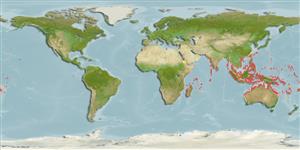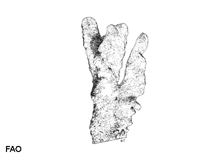Isopora palifera (Lamarck, 1816)
Catch bowl coral| Native range | All suitable habitat | Point map | Year 2050 |

|
| This map was computer-generated and has not yet been reviewed. |
| Isopora palifera AquaMaps Data sources: GBIF OBIS |
Classification / Names Common names | Synonyms | CoL | ITIS | WoRMS
Anthozoa | Scleractinia | Acroporidae
Environment: milieu / climate zone / depth range / distribution range Ecology
Reef-associated; depth range 2 - 20 m (Ref. 98471). Tropical; 28°N - 34°S, 27°E - 170°W (Ref. 846)
Distribution Countries | FAO areas | Ecosystems | Occurrences | Introductions
Indo-Pacific. Tropical to subtropical.
Length at first maturity / Size / Weight / Age
Maturity: Lm ? range ? - ? cmCommon length : 9.9 cm DL male/unsexed; (Ref. 269)
Short description Morphology
Colonies are formed of thick encrustations that develop atout (usually less than 10 cm in diameter), vertical, irregulary shaped branches, depending on exposure to wave action. May dominate wave-washed communities due to its solid construction. Axial corallites are difficult to distinguish due to the large area of branch tip. Many colonies consist of less than 12 main branches (Ref. 269).
Usually less than 10 cm. Common in shallow and intermediate depths (Ref. 269). Occurs subtidally on deeper areas of reef flat, edge, slope, walls and submerged reefs (Ref. 98471).
Life cycle and mating behavior Maturity | Reproduction | Spawning | Eggs | Fecundity | Larvae
Hermaphroditic (Ref. 113712). Mature gametes are shed into the coelenteron and spawned through the mouth. Life cycle: The zygote develops into a planktonic planula larva. Metamorphosis begins with early morphogenesis of tentacles, septa and pharynx before larval settlement on the aboral end (Ref. 833).
Main reference
References | Coordinator | Collaborators
Hodgson, G. 1998. (Ref. 269)
IUCN Red List Status (Ref. 130435)
Near Threatened (NT) ; Date assessed: 03 January 2008
CITES status (Ref. 108899)
Appendix II: International trade monitored
CMS (Ref. 116361)
Not Evaluated
Threat to humans
Human uses
| FishSource |
Tools
More information
Internet sources
BHL | BOLD Systems | CISTI | DiscoverLife | FAO(Publication : search) | Fishipedia | GenBank (genome, nucleotide) | GloBI | Gomexsi | Google Books | Google Scholar | Google | PubMed | Hexacorallians of the World | Tree of Life | Wikipedia (Go, Search) | Zoological Record
Estimates based on models
Preferred temperature
(Ref. 115969): 24.7 - 29.3, mean 28.5 (based on 3296 cells).
Price category
(Ref. 80766):
Unknown.



